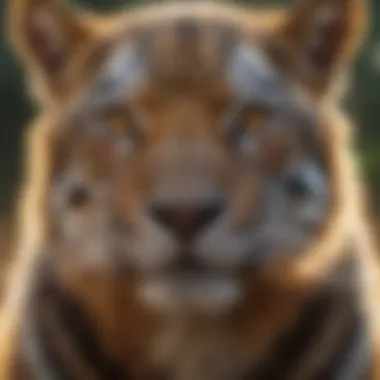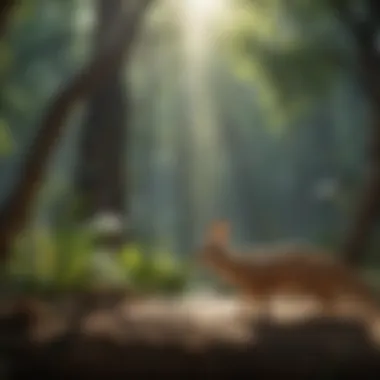Exploring the Impact of Linear UVB Light on Animal Life


Intro
Linear UVB light plays a vital role in the life of many animal species. This section seeks to outline its impact on various aspects of animal biology and behavior. The unique characteristics of linear UVB light influence several physiological processes, ranging from vitamin D synthesis to skin health in animals. Understanding this can provide insights into the ecological significance of linear UVB light, especially in relation to behavior, reproduction, and habitat selection.
Additionally, the potential applications in wildlife management and conservation are pertinent in light of ongoing environmental changes. Examining these components can deepen the comprehension of animal life within their ecosystems and the possible repercussions of artificial linear UVB sources.
Fascinating Facts About the Animal
Unique Characteristics
Many animals exhibit distinctive features that allow them to adapt to their environment. For instance, reptiles utilize UVB light not just for vital metabolic processes but also for their behavioral patterns. Lizards, for example, need exposure to UVB light to effectively process calcium, which is crucial for their overall health and bone development.
Extraordinary Abilities
Some species have demonstrated fascinating adaptations to enhance their utilization of linear UVB light. For example, certain fish species have developed reflective skin that helps maximize their exposure to available UVB rays. This ability plays an important role, especially in shallow waters where UVB light penetration is more pronounced. Such capabilities show how deeply intertwined animal life is with environmental resources like linear UVB light.
Behavior and Habitat
Natural Habitats
Linear UVB light is significant in various habitats, influencing not just animal health but also their behavior. For instance, animal species in tropical regions, where sunlight is abundant, depend heavily on linear UVB light for reproductive functions and maintaining ecological balance within their habitats.
Social Structures
In social species, exposure to linear UVB light can impact interactions among members. It can affect mating rituals and territorial behaviors, which are crucial to the survival of certain species. In this regard, understanding how UVB light affects social structures can offer deeper insights into wildlife dynamics and their ecosystems.
Recent Scientific Discoveries
Latest Research Findings
Recent studies have highlighted important links between linear UVB light and animal health. Investigations have shown variations in animal behavior correlated with changes in UVB exposure levels. These emerging findings contribute to the broader understanding of how animals might respond to environmental changes, including the impacts of climate change on sunlight availability.
Breakthroughs in Animal Biology
Breakthroughs in animal biology link linear UVB light to phenomena such as seasonal migrations and breeding cycles. Knowing how UVB light influences these events can aid in wildlife conservation efforts, ensuring populations adapt appropriately to changing environments.
Cultural Significance
Animals in Folklore
Linear UVB light is not only scientifically significant but also culturally important. Many cultures regard animals that thrive in UV-rich habitats as symbols of vitality and health. These aspects play a role in shaping local folklore.
Influence on Art and Literature
Art and literature often depict animals that are emblematic of health and vibrancy due to their ability to harness UVB light effectively. Such representations highlight the perceived significance of these animals in society, reflecting how human understanding of nature evolves over time.
In summary, linear UVB light holds profound implications for the health and behavior of animals. By exploring its multifaceted impacts, we gain crucial insights that enhance our approaches to wildlife conservation and management.
Understanding Linear UVB Light
The significance of comprehending linear UVB light encompasses a multidimensional exploration of its biological, ecological, and practical implications. Linear UVB light is essential for various metabolic processes within animal life. By understanding its properties and characteristics, one can appreciate how this light influences not only individual species but entire ecosystems.
Definition of UVB Light


UVB light refers to ultraviolet B radiation, which has a wavelength range of 280 to 320 nanometers. It exists in the spectrum of sunlight and is distinct from UVA (320 to 400 nanometers) and UVC (100 to 280 nanometers). Unlike UVC, which is absorbed by the Earth’s atmosphere, UVB reaches the surface and affects living organisms directly. Its biological relevance is profound, as it stimulates processes including vitamin D synthesis in many animals.
Characteristics of Linear UVB Light
Linear UVB light possesses unique attributes that set it apart from other forms of UV radiation. Its intensity varies with geographical location and time of year. Factors such as altitude, ozone layer thickness, and cloud cover also influence UVB levels.
Notably, linear UVB light can penetrate the atmosphere effectively. This penetration leads to direct exposure of terrestrial and aquatic species to UVB.
Key characteristics include:
- Wavelength Range: Specifically between 280 to 320 nanometers.
- Biological Impact: Influencing enzyme activity related to metabolic processes.
- Variability: Changes with seasons, latitude, and environmental conditions.
Understanding these elements is crucial for recognizing how UVB light impacts health and behavior in animal species.
Biological Importance of Linear UVB Light
The biological importance of linear UVB light is profound, as it serves critical functions in the health and behavior of various animal species. This section details two main factors: vitamin D synthesis and skin health. Understanding these elements is vital in comprehending how UVB light influences animal biology and can also guide practices in wildlife management and conservation.
Vitamin Synthesis
Vitamin D is essential for healthy bones and overall physiological function. Animals synthesize vitamin D when their skin absorbs ultraviolet B (UVB) light. In this process, the skin converts 7-dehydrocholesterol, a compound found in the skin, into previtamin D3, which eventually transforms into vitamin D3 when exposed to heat. This particular vitamin plays an important role in calcium regulation, supporting skeletal health and enhancing immune function.
Certain animals, like reptiles and amphibians, require specific amounts of UVB to adequately produce vitamin D. The lack of adequate exposure can lead to diseases such as metabolic bone disease, which significantly impacts their health and survival rates. Therefore, it is necessary to understand the habitat and lifestyle of these species to ensure they receive sufficient UVB exposure.
Role in Animal Behavior
The influence of linear UVB light extends notably into the realm of animal behavior. This section sheds light on specific elements such as circadian rhythms and foraging patterns. Understanding these behaviors is fundamental as they have direct implications for survival, reproduction, and ultimately, the health of species in diverse ecosystems.
Circadian Rhythms
Circadian rhythms are biological processes that follow a roughly 24-hour cycle. These rhythms are influenced by environmental cues, and linear UVB light plays a significant role in regulating them. For many animals, exposure to linear UVB light is crucial for maintaining their sleep-wake cycles, hormone release, and overall behavior patterns. Disruption in accessing this light can lead to adverse effects, including altered activity patterns and impaired physiological functions.
Research indicates that many species synchronize their behaviors with the presence of natural daylight, which includes UVB light. For instance, reptiles often bask in sunlight to regulate their body temperature and metabolic rates. By doing so, they ensure they receive adequate UVB exposure, which is essential for processes like vitamin D synthesis. This light triggers various internal clocks in animals, ensuring they remain active during optimal periods for feeding, mating, and other survival-related behaviors.
Foraging and Feeding Patterns
Linear UVB light also influences foraging and feeding behaviors across various species. Animals are generally more active during times when sunlight, including UVB, is available. Foraging strategies can vary based on the level of UVB light in the environment.
For example, birds often adjust their scavenging and hunting practices based on the time of day and the position of the sun. The presence of UVB light impacts visibility, aiding birds in finding food more efficiently. Additionally, some aquatic animals like fish rely on UVB light for their foraging. Studies indicate that UVB can enhance certain visual abilities, allowing these creatures to detect prey in varied conditions.
Influence on Reproductive Strategies
The influence of linear UVB light on reproductive strategies is critical in understanding animal life. It affects various aspects of reproduction, from mating behaviors to the nurturing of offspring. The relationship between exposure to UVB light and reproductive outcomes can inform wildlife biologists and veterinarians on how to protect and manage species effectively. Furthermore, considering how linear UVB light interacts with environmental factors is crucial for conservation strategies.
Mating Seasons and Photoperiod
Mating seasons in many animal species are closely linked to photoperiod, which refers to the length of day and night. Linear UVB light plays a role in regulating this photoperiod, influencing hormonal cycles that determine mating behaviors. For example, many reptiles and amphibians exhibit breeding patterns that align with UVB exposure during specific seasons.
Research shows that increased UVB light during spring can trigger reproductive readiness in certain species. This synchronization ensures that offspring are born during times of favorable environmental conditions. This impact can particularly be seen in animals like frogs, which often time their calls and mating rituals with the presence of UVB light.
Some species have adapted their mating habits to maximize exposure to UVB light, which may contribute to successful reproduction. A balanced photoperiod allows animals to optimize their reproductive strategies in response to UVB variability, leading to increased offspring survival rates.
Ecological Significance of Linear UVB Light
The ecological significance of linear UVB light extends far beyond its role in individual species. It serves as a vital component of ecosystems, influencing various biological processes that sustain life. By affecting dynamics of both fauna and flora, linear UVB light plays a role in shaping habitats and food webs. Understanding this significance is crucial in fields such as wildlife management and conservation.


Impact on Ecosystems
Linear UVB light significantly influences ecosystems. It affects plant growth and health, which provides the foundation for various food webs. Plants utilize linear UVB light for photosynthesis, facilitating energy capture from the sun. Moreover, certain wavelengths can stimulate the production of secondary metabolites in plants. These compounds help plants resist pests or diseases, which is important for maintaining ecological balance.
Additionally, the presence of linear UVB light impacts trophic levels. Many herbivores rely on specific plant species that thrive under optimal UVB exposure. If linear UVB levels fluctuate, it could lead to changes in plant communities. Such changes may further impact the herbivores and, consequently, the predators that rely on them. The cascading effects illustrate how changes in UVB light can disrupt the overall health of an ecosystem.
Linear UVB light shapes the very fabric of ecosystems, influencing interactions from the ground up.
Further, linear UVB light acts as a environmental cue for various organisms. Species have adapted their behaviors and lifecycles in response to the availability of UVB light. These adaptations can determine migration patterns, breeding times, and hibernation behaviors. For example, many amphibians are sensitive to UVB levels, which in turn influences their reproduction and habitat choices. As researchers continue to study these dynamics, it becomes clear that maintaining natural UVB levels is essential for conserving biodiversity.
Interactions with Flora
The interactions between linear UVB light and flora are complex and significant. Different plant species exhibit varying levels of sensitivity to UVB light. Some plants thrive in environments with high levels of UVB exposure, while others show inhibited growth under bright UVB conditions. This variability allows for a more diverse plant community, where each species occupies a specific niche according to its UVB sensitivity.
Moreover, linear UVB light can stimulate the synthesis of essential compounds in plants, such as flavonoids and phenolics. These compounds are not only vital for the plants themselves, serving protective functions, but they are also critical in the diets of herbivores and higher trophic levels.
In addition to influencing growth and chemical production, UVB light impacts the spatial distribution of plant species. Areas with optimal UVB light can support different species compared to shaded environments. Consequently, plant competition and coexistence dynamics are heavily influenced by UVB levels.
Understanding these interactions is vital for ecological management. Conservation efforts need to consider how alterations to light environments can affect plant communities and, subsequently, the entire ecosystem. As artificial light sources increase and natural habitats diminish, the implications for flora highlight the need for informed decision-making in conservation strategies.
Applications in Wildlife Management
The application of linear UVB light in wildlife management is gaining significance in understanding the interactions between light and animal ecology. Wildlife practitioners increasingly recognize the influence of UVB light on animal physiology and behavior. This knowledge enhances strategies focused on conservation and habitat restoration.
One important aspect of this discussion is the restoration of natural habitats. UVB light plays a critical role in the growth of vegetation, which serves as food and shelter for many species. Promoting the appropriate exposure to linear UVB during habitat restoration enhances plant health, thus ensuring a more sustainable environment for animals.
Furthermore, linear UVB light augments human efforts in monitoring animal populations. Understanding the health of these populations is paramount for effective wildlife management. Implementing UVB light sources in controlled environments can ensure that laboratory or rehabilitated animals have access to this essential light spectrum, facilitating better growth and recovery.
Quote: The effective use of UVB light in wildlife management can influence animal health and ecological balance, ultimately benefiting biodiversity as a whole.
Key considerations in applying linear UVB light include:
- Species-Specific Needs: Different species possess unique requirements regarding UV exposure.
- Timescale of Effects: The results of UVB application may take time to manifest, necessitating long-term planning.
- Monitoring Systems: Effective monitoring is crucial to assess the impact of linear UVB.
The integration of linear UVB light into wildlife management is not a mere technical addition; it represents a paradigm shift in how we understand and interact with animal ecosystems. Recognizing the multifaceted role of UVB in ecology equips wildlife professionals with new tools to enhance conservation efforts.
UVB in Habitat Restoration
Understanding the role of linear UVB light in habitat restoration is critical for ensuring ecological integrity. This light spectrum supports the photosynthesis process, thereby promoting plant growth. Healthy vegetation forms the foundation of many ecosystems, providing shelter and food for diverse animal populations.
When selecting plants for restoration projects, it is vital to consider their UVB light requirements. Some species thrive under higher UV exposure, while others may not. Here, determining the optimal levels of linear UVB becomes essential. Additionally, careful planning regarding light exposure should accompany restoration activities, ensuring adequate UVB is available throughout the growth period.
Implementing UVB light treatments can produce positive outcomes, such as:
- Increased plant resilience toward diseases
- Enhanced biodiversity by allowing diverse plant species to flourish
- Support of breeding grounds for various animal species
Inclusion of linear UVB light in habitat restoration practices enhances strategies that stakeholders can adopt to make measurable improvements in ecosystems.
Monitoring Animal Health
The monitoring of animal health through linear UVB light applications is a significant concern for wildlife managers. Linear UVB light is essential for synthesizing vitamin D, which plays a vital role in calcium metabolism and overall health in many species.
Effectively monitoring animal health involves implementing UVB exposure in controlled settings. Such environments can replicate natural conditions, thus allowing veterinarians and wildlife biologists to observe effects in real-time. Proper light exposure helps detect health issues early, ultimately facilitating timely interventions.
Key advantages of monitoring animal health using UVB light include:


- Disease Prevention: Improved UV exposure can lower the risk of disorders like rickets or metabolic bone disease.
- Healing and Recovery: For rehabilitating animals, UVB light can promote faster recovery by enhancing vitamin D synthesis.
- Behavioral Studies: Observations of behavior in conjunction with controlled UVB exposure can help researchers understand species-specific needs.
Artificial Linear UVB Light Sources
Artificial sources of linear UVB light represent a vital aspect of wildlife science, as they mimic natural ultraviolet conditions found in the environment. Understanding these sources helps researchers and practitioners manage animal health and behavior effectively. The capability to provide a consistent UVB spectrum allows for controlled studies, essential for determining the impact of linear UVB light on various species. The importance lies significantly in its application in research, conservation efforts, and veterinary care.
Types of Artificial UVB Sources
Artificial linear UVB sources vary widely, including:
- Fluorescent UVB Bulbs: These bulbs are common in laboratories and zoos. They generally provide a wide spectrum of UV radiation, mimicking natural sunlight.
- Compact Fluorescent Lamps (CFLs): Smaller and more energy-efficient, CFLs often contain UVB radiation primarily targeted at reptile habitats.
- Metal Halide Lamps: Known for their high intensity, metal halide lamps produce a broad spectrum of light, beneficial in large enclosures.
- LED UVB Lights: A more recent innovation, these lights are designed for efficiency and do not emit much heat, making them suitable for sensitive environments.
Understanding the characteristics and utilities of each type is crucial for researchers focused on accurate data collection in studies.
Effects on Laboratory Animals
The use of artificial linear UVB light sources in laboratory settings has critical implications for animal health and research outcomes. Laboratory animals, including reptiles and amphibians, often rely on UVB exposure for biological functions such as:
- Vitamin D Metabolism: UVB light enables vitamin D production, crucial for calcium absorption. A deficiency can lead to metabolic bone disease in species like turtles and lizards.
- Behavioral Studies: Animals exposed to proper UVB levels often exhibit more natural behaviors, influencing the validity of research results.
- Health Assessments: In studies involving health monitoring, appropriate UVB exposure can lead to clearer results concerning treatment efficacy and overall animal wellness.
The balance of light exposure is essential. Too much or too little UVB can harm animal subjects, impacting research integrity.
Using artificial linear UVB light sources is not without concerns. Researchers must monitor the duration and intensity of exposure to avoid adverse effects on animal life. As research evolves, a deeper understanding of how varying types of UVB light influence laboratory animals will be paramount for future studies.
Potential Implications for Conservation
The influence of linear UVB light extends beyond the physiological aspects of animal life; it holds significant implications for conservation strategies. Understanding its effects can aid wildlife biologists and conservationists in developing targeted initiatives that enhance ecosystem health and species survival. Through careful integration of UVB light in conservation practices, there emerges a potential for more resilient habitats and fauna.
Conservation Strategies Utilizing UVB
Using linear UVB light presents various opportunities for conservation strategies. These strategies can help address habitat degradation and species decline. Specific elements of these strategies include:
- Habitat Enhancements: Incorporating natural UVB light in habitat restoration projects can improve conditions for species that rely on sunlight for vital processes like reproduction and foraging.
- Supplemental Lighting: For certain species residing in shaded or degraded environments, using artificial linear UVB light can provide a necessary boost in vitamin D synthesis, thus promoting overall health and resilience.
- Monitoring and Research: Employing UVB light as a monitoring tool can enable scientists to assess the health of ecosystems. For example, analyzing animal behaviors in relation to UVB exposure can offer insights into environmental stressors and their impacts.
By leveraging these strategies, conservationists can create a holistic approach aimed at supporting wildlife affected by changing environmental conditions.
Long-term Effects on Biodiversity
The long-term effects of linear UVB light on biodiversity are significant and warrant attention. The repercussions of UVB exposure are multifaceted, impacting both individual species and the broader ecological community. Understanding these long-term effects involves several considerations:
- Species Adaptation: Over time, species may adapt to varying UVB levels, leading to shifts in population dynamics and community structures. This adaptation could foster resilient species capable of thriving in diverse environments.
- Ecosystem Balance: Changes in UVB exposure can influence plant growth and, consequently, herbivore populations. Plants that benefit from optimal UVB exposure can flourish, providing food and habitat for various herbivores, which in turn supports predator populations.
- Potential Declines: Conversely, certain species may not withstand the effects of increased UVB exposure, leading to declines. Endangered species that are already under stress may struggle further, leading to potential extinction risks.
Understanding the long-term implications of linear UVB light is crucial for informed conservation efforts.
In summary, recognizing the importance of linear UVB light in conservation strategies is essential for enhancing the prospects of biodiversity. Efforts that consider these nuances may help create sustainable environments where wildlife can thrive.
Future Research Directions
Gaps in Current Knowledge
Current research has highlighted several critical areas where knowledge is lacking regarding linear UVB light. This lack of information may hinder effective wildlife management and conservation strategies moving forward. Several gaps include:
- Species-Specific Responses: Different species exhibit varied responses to UVB light. More studies are necessary to understand these specifics, particularly in relation to skin structure, behavior, and reproductive strategies.
- Long-Term Effects: While short-term impacts are documented, the long-term effects of UVB exposure on animal populations remain understudied. Research needs to focus on multi-generational studies to assess cumulative impacts.
- Ecological Interactions: There is limited understanding of how linear UVB light affects predator-prey dynamics and interspecies relationships. Further investigation can provide clarity on ecosystem health.
- Artificial Light Sources: As artificial UVB sources become more common in research settings, their long-term effects on both laboratory animals and wild populations need examination. The importance of these studies cannot be overstated to avoid unintended consequences on wildlife.
Emerging Technologies in UVB Research
With advancements in technology, new avenues for UVB research are presenting themselves. These technologies can significantly enhance our understanding of the effects of linear UVB light on animal life. Key developments include:
- Remote Sensing: This technology allows researchers to measure UV radiation in specific habitats remotely. Such tools can provide insights into microhabitat variations and expose animals to different UVB levels.
- Genetic Studies: Advances in genetic sequencing technologies enable scientists to analyze how UVB light interacts with genetic factors. Understanding these intersections can shed light on how some species are better adapted to UVB exposure than others.
- Behavioral Tracking: Use of GPS collars and bio-loggers can help monitor animal behavior related to UVB exposure. This data will be crucial for examining how UVB light influences foraging, mating, and other behavioral patterns over time.
- Laboratory Simulations: New simulation technologies are allowing researchers to replicate natural UVB environments in controlled settings. This can lead to a better understanding of direct and indirect effects on different animal species.
Investing in these research directions will not only expand our understanding of linear UVB light but also provide valuable data for developing conservation strategies and managing wildlife health effectively.







